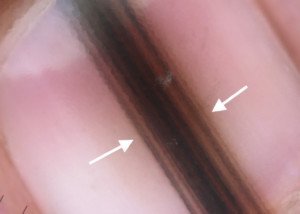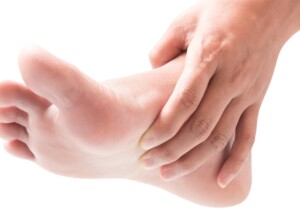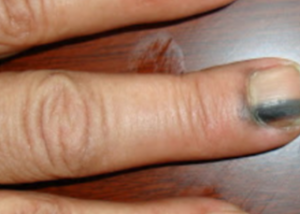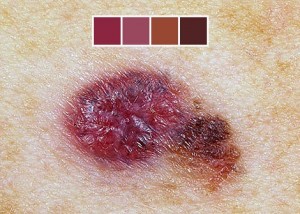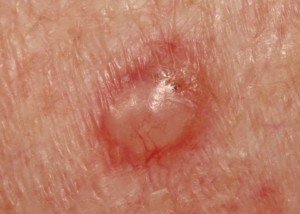Part of the Body Melanoma Most Often Grows in Dark Skin

There are certain parts of the body that melanoma is more likely to grow in blacks and other dark skinned individuals.
People with dark skin are not immune to melanoma, especially since this skin cancer has risk factors not related to sun exposure, the ability to tan or how much natural pigment a person has. (more…)
How Rare Is Melanoma in Dark Skinned Children?

Though melanoma is very rare in children, and rare in dark skinned adults, just how rare is it in a person who’s both dark and under age 20? (more…)
Causes of Barrett’s Esophagus Other than GERD

Barrett’s esophagus is a risk factor for esophageal cancer. GERD causes Barrett’s esophagus.
But what else might cause this precancerous condition?
“The lining (epithelium) of the esophagus is normally what is called a squamous epithelium, exactly like our skin,” says Alex Little, MD, a thoracic surgeon with a special interest in esophageal and lung cancer.
“Barrett’s esophagus is a condition in which the epithelium near the bottom of the esophagus is found to be glandular; it resembles cells found in glands,” explains Dr. Little.
“All these patients have GERD, and the understanding is that the acid that refluxes from the stomach injures the normal squamous epithelium — which is replaced by stem cells that migrate in and develop a columnar lining.
“There are no other known causes, although during fetal development columnar cells line the esophagus.
“They are usually replaced by squamous cells before birth, but occasionally ‘nests’ of columnar cells remain. This is not Barrett’s.”
About 10 percent of people with chronic gastroesophageal reflux disease will develop Barrett’s esophagus.
And most people with Barrett’s have a long history of GERD.
It’s not known why that small percentage of acid reflux sufferers eventually develop Barrett’s esophagus.
A study in Gastroenterology (2012) links smoking to Barrett’s, but the relationship is not clear.
There’s not enough evidence to date to show a strong correlation to smoking and this precancerous condition, let alone how the link occurs.
Type 2 diabetes and obesity have also been implicated as possible risk factors for Barrett’s, but again, the links are associative rather than causal.
 Alex Little, MD, trained in general and thoracic surgery at the Johns Hopkins University School of Medicine; has been active in national thoracic surgical societies as a speaker and participant, and served as president of the American College of Chest Physicians. He’s the author of “Cracking Chests: How Thoracic Surgery Got from Rocks to Sticks,” available on Amazon.
Alex Little, MD, trained in general and thoracic surgery at the Johns Hopkins University School of Medicine; has been active in national thoracic surgical societies as a speaker and participant, and served as president of the American College of Chest Physicians. He’s the author of “Cracking Chests: How Thoracic Surgery Got from Rocks to Sticks,” available on Amazon.
 Lorra Garrick has been covering medical, fitness and cybersecurity topics for many years, having written thousands of articles for print magazines and websites, including as a ghostwriter. She’s also a former ACE-certified personal trainer.
Lorra Garrick has been covering medical, fitness and cybersecurity topics for many years, having written thousands of articles for print magazines and websites, including as a ghostwriter. She’s also a former ACE-certified personal trainer.
.
Top image: Freepik.com, pressfoto
Sources
sciencedaily.com/releases/2012/10/121022081232.htm; sciencedirect.com/science/article/pii/S0016508512000170
Do Dark Skinned People Ever Get Basal Cell Carcinoma?

Even though basal cell carcinoma is a skin cancer heavily associated with sun exposure among Caucasians, those with dark skin can still get this disease. (more…)
Burping from the Esophagus: Causes and Solutions
The good news about burping from the esophagus is that you don’t have to fear that this means cancer.
However, one of the causes, if left untreated, can lead to a condition that’s a risk factor for esophageal cancer. (more…)
How Common Is Phantosmia: Smelling Something that’s Not There?

If you’ve been smelling things that aren’t there (phantosmia), you’re in good company: lots of it.
Phantosmia is also far more common in people over the age of 40, says a study. (more…)
Can a Teenager Get Melanoma in the Mouth?
The answer is “Yes” to the question, Can a teen get melanoma of the mouth.
The most highly publicized presentation of melanoma is that of a “mole” on the skin. (more…)
Costochondritis or GERD? Symptom Overlap, Which Is It?

GERD and costochondritis (“costo”) both cause pain in the chest.
Both can cause enough chest pain to make a person think they’re having a heart attack.
But there are also differences between the chest pain of gastroesophageal reflux disease and costochondritis. (more…)
Why Your Poops Are Sometimes Pointy

Are the ends of your poops shaped like a spear or pointy?
Usually, when stools come out, they have bulbous or clumpy ends when they are well-formed.
But every so often, you may find that your formed stools resemble miniature torpedoes. (more…)
Chances of a 25 Year Old Having Throat Cancer



